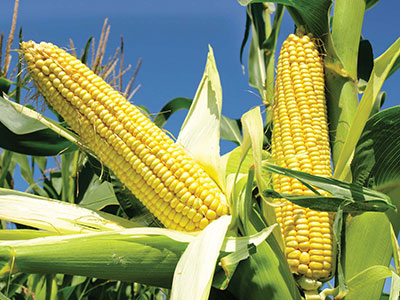AS we continue to observe the UN General Assembly’s International Year of Fruits and Vegetables (IYFV) to raise awareness on the important role of fruits and vegetables in human nutrition, food security and health and as well in achieving UN Sustainable Development Goals, NAREI in Focus will be sharing information on corn.
Corn (Zea mays) could be grown in both hinterland and coastal communities. The crop takes between 105 and 120 days to mature.
Intermediate Savannah
Soil type is sandy loamy with a pH of around 5.0.
Apply NPK fertilizer at 130:60:60 kg/ha to the crop. The full dose of P and K should be used at sowing along with a half dose of N (Urea). The remaining N (Urea) is applied in two equal split doses of 30 and 60 days after sowing.
The pre-emergence application of Round-Up weedicide @ 3lit/ha is used to control weeds.
Cultivating
Rows should have a distance of 60cm from each other. Use planting distance of 30cm.
Recommended sowing depth of 5-7cm and cover the seed with soil
Harvesting
Harvesting of ears should be done once the outer cover is dried. The harvested ears are peeled and sun-dried. The threshing of corn is done manually or mechanically.
Coastland
Soil type is clay loam with pH of about 5.5. Planting done on ridges (15-20cm high) using a planting distance of only 15 cm and row distance of 60cm.
Plant seeds using a depth of about 5cm.
Irrigation
Use sprinklers to ensure proper germination and crop establishment.
Harvest manually or mechanically after 105 days of sowing.
Maturity is assessed by looking at the drying of the outer cover of the ear and grain moisture. Harvest ears once the outer cover is dried. The harvested ears are peeled and sun-dried.
Pest and Disease Management
Armyworm: The full-grown 1 ½ inch armyworm has a greenish-brown body with a thin stripe down the centre and two orange stripes along each side. The head is brown with dark honeycombed markings. Eggs are small, greenish-white, globular, and lay in clusters of 25 or more the leave of grasses. The adult moth is tanned with a tiny white spot centre the wings.
Infestation of the armyworm usually first develops in fields of small grains or in other grass cover crop. In a conventional tillage system, partially grown larvae can migrate to cornfields through grassy waterways. Damage is first noticeable around the field margins adjacent to these areas.
 In no-till or reduced tillage system infestation may cover the entire field. In these systems, eggs may be laid on grasses within the field prior to planting and herbicides may force armyworm to feed on the corn as the weed dries up.
In no-till or reduced tillage system infestation may cover the entire field. In these systems, eggs may be laid on grasses within the field prior to planting and herbicides may force armyworm to feed on the corn as the weed dries up.
Damage
Armyworm feeding gives the corn a ragged appearance, with defoliation occurring from the leaf edge toward the midrib. Damage, maybe so extensive, that most of the plant except the leaf midribs and the stalk is consumed. Such a plant may recover if the growing point is not destroyed.
Management Guidelines
If more than 50 percent of plant shows armyworm feeding and numerous live larvae are less than 31mm, a control may be necessary. Larvae greater than 31mm will soon be pupating and application of control is not usually justified since the damage was already done. If the problem is identified early, particularly during migration spot treatment with Fasttac is applicable.
Good grass control before planting would lower the chance of armyworm breakout.
Watch for armyworms migrating out of maturing small grains into corn.
Planting in standing grass cover crops and then applying burndown herbicides may increase the chance of armyworm attack.
Grain Borer
Both the larvae and adults bore irregularly shaped holes into whole, undamaged kernels and the larvae, immature stages, may develop inside the grain. Larval and adult feeding in and on grain kernels may leave only dust and thin brown shells. A sweet, musty odour is often associated with infestations of this insect.
Description
The adults are 0.1 inches long, brown to black beetles with cylindrical bodies and numerous small pits on the wing covers. The head is directed downward and covered by the prothorax, so that is t is not visible when the insect is viewed from above. The creamy white larva is a c-shaped grub with a small dark head that is partly retracted into the thorax. The thorax has three pairs of small legs.
Control
Prevention is always the most economical and efficient method of controlling these pests. Once they are distributed within the grain mass, fumigation is the only method of relieving the problem.
The use of Bt is also recommended.
Nutritional Value
Corn is nutritious, providing fibre, which aids in digestion, plus folate, thiamin, phosphorus, vitamin C, and magnesium (about 10 percent of the daily value for each).



.jpg)











